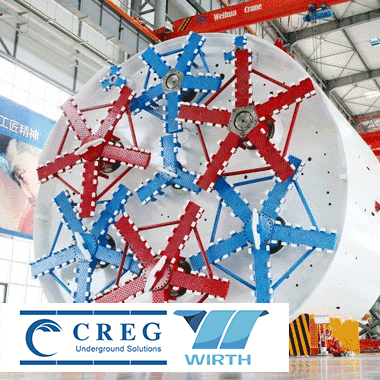Satellite solutions for tunnelling challenges 15 Dec 2016
Ground motion monitoring has become an important part of risk management when planning tunnelling projects. It increases the efficiency and safety of the tunnel excavation works and assists asset protection. For the large number of tunnelling projects to be carried out worldwide in the future, consistent monitoring is imperative to ensure the stability of the operating environment and to prevent project slippage.
TRE ALTAMIRA has developed and is using radar satellite technology to detect ground movements on the surface of the earth. This provides a time saving and cost effective solution for mapping ground displacement over wide areas. The technology, known as InSAR (interferometric synthetic aperture radar) compares radar images of the earth’s surface acquired over months and years to detect and map subtle movements of the ground (Fig 1). The images typically cover 50km2 to provide a comprehensive motion map of the construction location and the wider surrounding areas.
Looking into motion in the past
The first generation of radar satellites were launched in 1992 and since their advent have been collecting data and storing the acquired images in archives. With this data, historical studies can be undertaken to analyse what happened in the area before the start of construction.
Ground behaviour can thus be better understood, geotechnical parameters checked and excavation parameters adjusted accordingly in the design phase. This helps decide where to place the in-situ measurement control points during construction, and provide past motion information for use to settle claims.
The studies provide a vast amount of measurement points, sometimes in remote areas, so that project managers can assess the impact construction activities may have on the surroundings and nearby buildings, as well as obtain geotechnical information to better assess and plan tunnelling activities.The satellite technology also provides data on the shape, extension and value of settlements (fig 2). Time information on which areas remain in motion keeps stakeholders fully informed of the impact any ground motion may have on their works. Once excavation is completed, the settlement and ground stability can then be monitored regularly with InSAR studies to complement in-situ measurements.

Fig 3. Ground motion map for a Grand Paris Express section from 2011-2015 measuring ground motion for future reference
TRE ALTAMIRA is using satellite data to survey the ground for the Grand Paris Express Project in France (Fig 3) and it applied the technology during the last 16 years to monitor projects for Crossrail in London, the Public Transport Authority of Perth in Australia, Deutsche Bahn in Germany, Canada Line in Vancouver and ÖBB rail tunnel projects in Austria.
In future decades more underground solutions will need to be developed to address the lack of urban space. The use of satellite technology for mitigating risks on a manageable budget will be a valuable asset to the industry. Better understanding of terrain stability will result in better planning and enhanced operation continuity.
References
- Mapping ground movement from space – TunnelTalk, May 2012
- Space monitor for Hong Kong settlement – TunnelTalk, Sep 2011
|
|
|
|
|
Add your comment
- Thank you for taking the time to share your thoughts and comments. You share in the wider tunnelling community, so please keep your comments smart and civil. Don't attack other readers personally, and keep your language professional.



